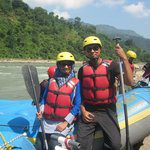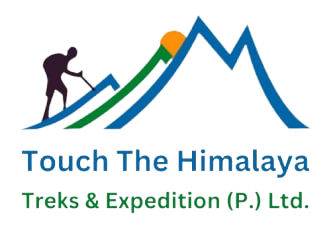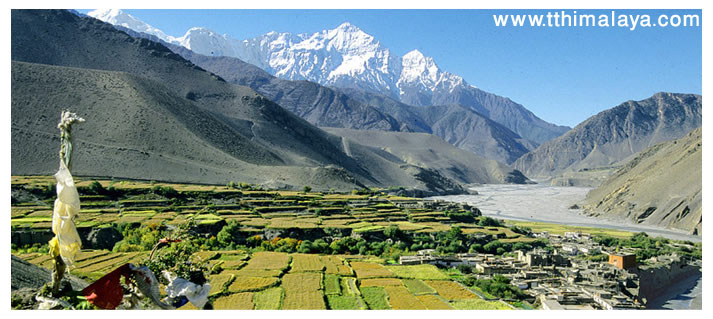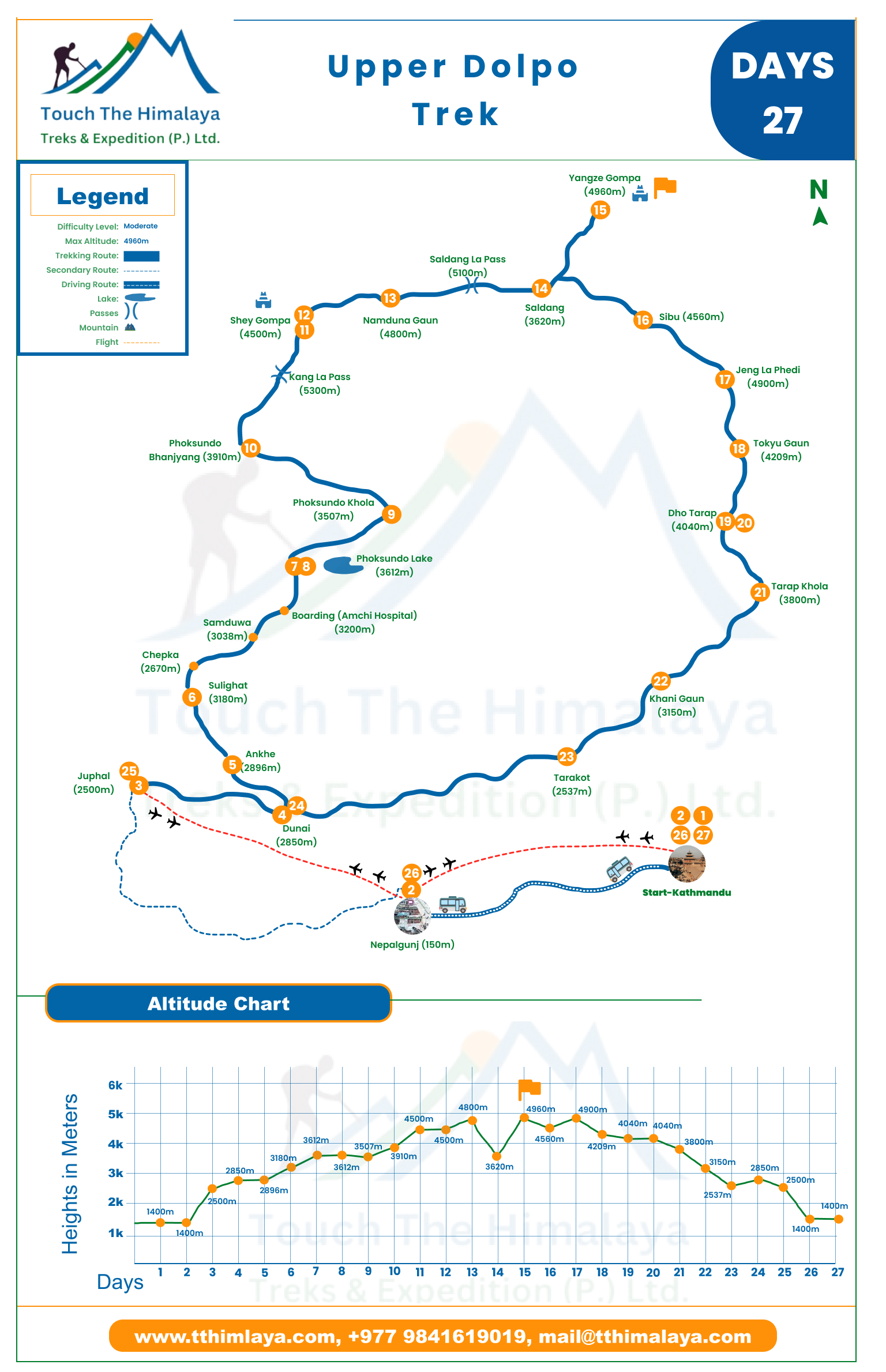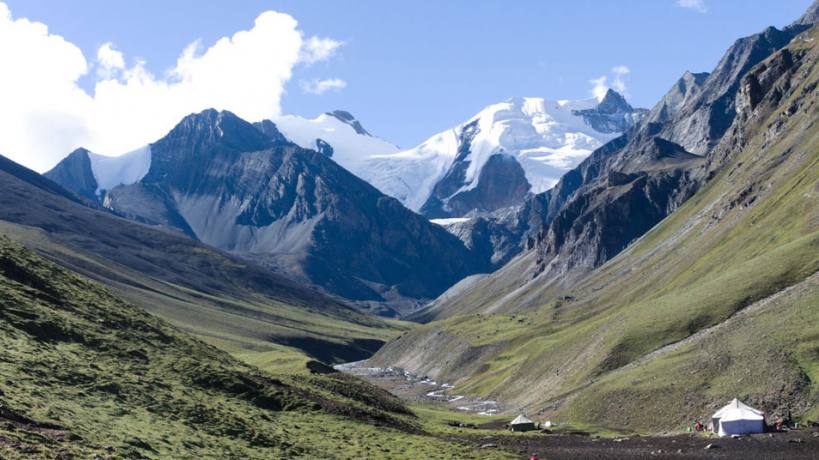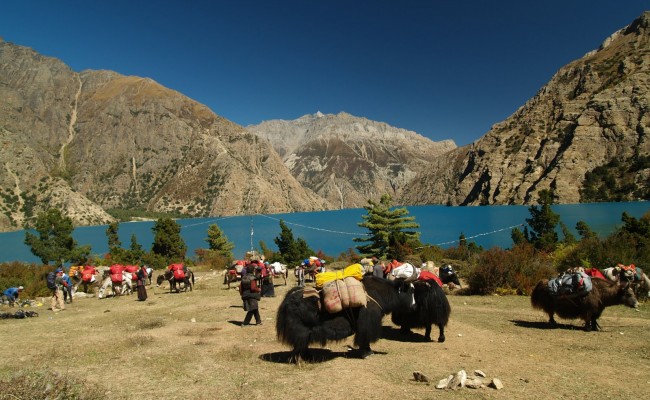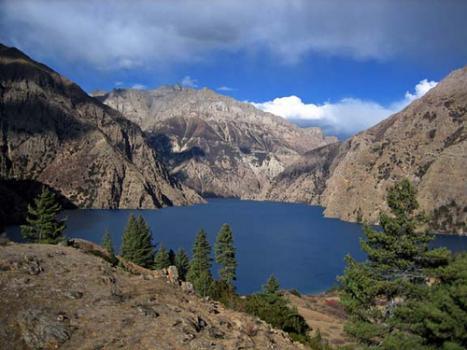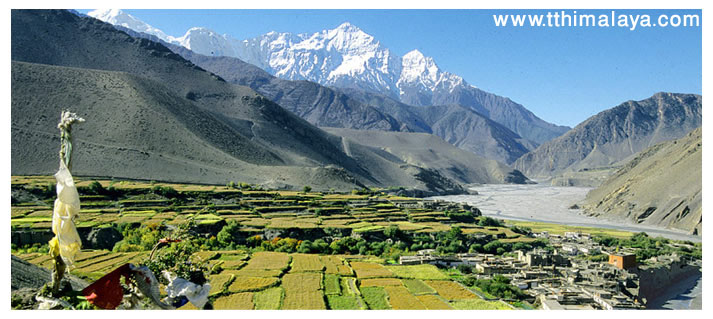Upper Dolpo Trekking - 27 Days
Remote & isolated-
Duration
27 Days
-
Activity
Trekking
-
DifficultyStrenuous Trek
These treks are suitable for experienced trekkers who are physically fit and have some prior experience in high-altitude trekking. The altitude may exceed 5,000 meters, and the terrain can be challenging with steep ascents and descents, rocky trails, and occasional snow or ice.
-
Max. Altitude
5,360 m | 17,581 ft
-
Starts
Kathmandu
-
Ends
Kathmandu
-
Group Size
Minimum: 2 pax
-
Best Season
Feb-June/Sept-Early Dec
PRICE PER PERSON
- 1 PAX US$3505
- 2 PAX US$2770
- 3 PAX US$2650
- 4 PAX US$2605
- 5-10 PAX US$2543
- 11-20 PAX US$2452
- Highlights
- Itinerary
- Route Map
- What Included / Excluded
- Dates & Availability
- Photos & Videos
- Additional Information
TRIP HIGHLIGHTS
- Authentic experience of rugged and barren landscapes, deep valleys, turquoise lakes, and breathtaking mountain views.
- Breathtaking views of some of Nepal’s highest peaks, including Dhaulagiri (8,167 meters), Kanjiroba (6,883 meters), and Gurja Himal (7,193 meters).
- Encounter rare and endangered species like the snow leopard, musk deer, blue sheep, and Himalayan tahr.
- Stunning Phoksundo Lake, a deep turquoise lake surrounded by snow-capped peaks.
- Challenging Kang La Pass (5,360 meters) and the Numa La Pass (5,190 meters).
- Shey Gompa, an ancient monastery located in Upper Dolpo, beautifully adorned with intricate murals, statues, and Tibetan Buddhist artifacts.
- Shey Phoksundo National Park, Nepal’s largest national park, renowned for its diverse flora and fauna.
- Ancient monasteries, chortens (Buddhist shrines), and prayer flags fluttering in the wind.
- Explore villages like Ringmo, Dho Tarap, and Saldang, known for their distinct cultural practices and warm hospitality.
Upper Dolpa Trek Overview
Upper Dolpa is located in the far western region of Nepal, bordering Tibet (China) to the north. It is part of the Dolpa district and lies within the Shey Phoksundo National Park. It is a remote and isolated place that is located in the Himalayas’ rain shadow. The Upper Dolpo Trekking is a challenging and remote trekking adventure that takes you through the stunning landscapes and culturally rich region of Upper Dolpo in Nepal. The journey is distinguished by its difficult terrain, deep valleys, high passes, and barren landscapes. Many magnificent peaks, including Mt. Dhaulagiri, Mt. Kanjirowa, and Mt. Annapurna can be found in the area.
The trek usually begins with a flight from Nepalgunj to Jhupal, a small airstrip in the Dolpa region. Jhupal serves as the starting point for the trek. After landing in Jhupal, you’ll trek to Dunai, the administrative headquarters of the Dolpa district. Dunai is a charming village situated on the bank of the Bheri River. From Dunai, the trek continues to Ankhe. The trail passes through terraced fields, forests, and picturesque landscapes, offering glimpses of the local culture and rural lifestyle.
The trek proceeds towards Sulighat and Renje, where you’ll cross suspension bridges and follow the winding trail along the banks of the Suli River. The trek takes you to the mesmerizing Phoksundo Lake, one of the deepest lakes in Nepal. Its crystal-clear waters and surrounding cliffs create a stunning visual spectacle. The lake is considered sacred by the locals and is a major highlight of the trek.
From Phoksundo Lake, you’ll trek to Ringmo, a traditional village located near the lake. Ringmo offers a chance to experience the local culture, interact with the villagers, and visit the ancient monastery. Trekking further, you’ll reach Shey Gompa, an ancient and significant monastery in Upper Dolpo. The monastery is adorned with beautiful murals, statues, and religious artifacts. Explore the monastery and soak in the spiritual ambiance.
The trek involves crossing high mountain passes, including Kang La Pass (5,360 meters) and Numa La Pass (5,190 meters). These passes offer panoramic views of the Himalayas and are a test of endurance and perseverance. The next destination is Saldang, one of the largest villages in Upper Dolpo. It is known for its ancient architecture, narrow alleys, and terraced fields. Immerse yourself in the local culture, visit the monasteries, and interact with the friendly locals.
Continuing the trek, you’ll reach Dho Tarap, another traditional village in Upper Dolpo. Dho Tarap offers insights into the traditional lifestyle, architecture, and customs of the local Tibetan Buddhist community. Due to the remoteness of the region, camping is the primary accommodation option during the Upper Dolpo Trek. Sleeping under a starry sky, surrounded by the serenity of the mountains, is an incredible experience. Camping also allows you to be closer to nature and fully immerse yourself in the rugged beauty of the landscape.
Wildlife and Flora:
A diversity of flora and fauna, some of which are uncommon and endangered, can be found in the area. The terrain and climate of the Upper Dolpo region have a significant impact on the wildlife and vegetation that may be found there.
The endangered snow leopard is one of the most remarkable creatures to be found in the area. Tibetan wolves, musk deer, and Himalayan blue sheep are some of the other creatures that can be seen nearby. The region is especially fascinating for birdwatchers because it is home to a variety of bird species, including the Himalayan monal, Tibetan snowcock, and yellow-billed chough.
The Upper Dolpo region is home to a diverse range of plants, including medicinal herbs and plants. Lower levels have rhododendron forests, whereas higher elevations include alpine meadows and high-altitude deserts. Higher elevations have juniper and dwarf rhododendron shrubs, while alpine meadows feature saxifrage, gentians, and primroses, among other alpine species.
Culture & People:
The Dolpo-pa people make their living through subsistence farming, animal husbandry, and trading. They follow a variety of Buddhism that has been greatly impacted by the Bon religion, which predominated in Tibet before Buddhism arrived. The Dolpo-pa are well recognized for their sophisticated weaving and the creation of yak-wool-based traditional apparel.
The residents of Upper Dolpo are renowned for their friendliness and unique festivals, which are significant components of their culture. The most well-known of these celebrations is the yearly Phoksundo Lake Festival, which honors the magnificence of the largest lake in the area and draws visitors from all across Dolpo.
Visitors should be respectful of the Dolpo-pa people’s traditions and way of life because it is vital to notice that they have not had much exposure to contemporary conveniences and technology. Visitors are urged to become familiar with the customs and culture of the area and to interact meaningfully and respectfully with the locals.
Accomodation & Logistics:
Because of its remote and underdeveloped location in Nepal, Upper Dolpo has few and basic lodging options. Most hikers will stay in teahouses or homestays, which are modest lodgings with shared bathrooms and minimal amenities like beds. It’s possible that some teahouses serve meals as well, but it’s wise to pack your own snacks and water because there might not be enough on hand.
For those who want a more daring and flexible trek, there are a few camping choices available. You can engage a trekking company that offers all the required supplies and support, or you can carry your own tent and gear.
Upper Dolpo’s remote location and sparse infrastructure make logistics there difficult. The best method to reach there is to take a domestic flight from Juphal, where the journey begins, to Nepalgunj. The trek is difficult, so you should come equipped with the right equipment and clothing for the high altitude and chilly weather.
Climate:
The climate in Upper Dolpo is generally dry and arid due to its location in the rain shadow of the Himalayas. The best time to undertake the trek is during the spring (April to May) and autumn (September to November) seasons when the weather is generally stable. During these seasons, temperatures are moderate, with daytime temperatures ranging from 10°C to 20°C (50°F to 68°F) and nighttime temperatures dropping below freezing at higher altitudes. However, it’s important to note that temperatures can vary significantly, and weather conditions can change rapidly, so it’s essential to be prepared for all weather conditions.
Duration:
The duration of the Upper Dolpo trekking can vary depending on the specific itinerary and individual trekking pace. On average, the trek takes around 20 to 25 days to complete. The trek usually starts and ends in Juphal, covering a vast and remote area of the Dolpo region. The duration can be customized based on personal preferences and side trips, such as exploring Shey Phoksundo Lake or visiting remote villages. Due to the rugged and challenging terrain, the trek requires sufficient time for acclimatization and rest days to ensure the well-being and enjoyment of trekkers.
Meals:
During the Upper Dolpo trek, meals are typically provided at tea houses or lodges along the trail. However, it’s important to note that the options for meals might be limited in this remote region. Meals usually include a combination of local and basic international dishes, such as rice, lentils, vegetables, noodles, and Tibetan bread. As the region is far from major towns or supply chains, it’s recommended to carry some energy bars, snacks, and water purification tablets for additional sustenance during the trek. It’s also possible to arrange for a cook or kitchen staff to accompany the trekking group for a more customized and varied menu.
Insurance:
We highly recommend travel insurance for the Upper Dolpo Trekking, and we can assist you in acquiring suitable coverage. We work with reputable insurance providers to help you obtain comprehensive insurance that includes high-altitude trekking and helicopter evacuation in case of emergencies. We want to ensure that you are adequately protected throughout your trekking journey.
Guides:
Due to the remote and challenging nature of the Upper Dolpo trekking, it is highly recommended to have experienced and knowledgeable guides. These guides are familiar with the trail, local culture, customs, and terrain. They provide valuable guidance, assistance, and support throughout the trek. Experienced guides can help navigate the challenging sections of the trail, ensure proper acclimatization, and share insights about the region’s culture and natural surroundings. They also play a crucial role in ensuring the safety and well-being of the trekkers.
Permits:
To trek in Upper Dolpo, you need to obtain certain permits. These include the Shey Phoksundo National Park Permit, the Dolpa Restricted Area Permit, and the TIMS (Trekkers’ Information Management System) card. These permits can be obtained through a registered trekking agency, and they help in maintaining conservation efforts and regulating tourism in the area.
Difficulty Level:
The Upper Dolpo Trekking is considered a challenging trek. The trail involves steep ascents and descents, crossing high mountain passes, and trekking through rugged and remote terrain. The altitude also poses a challenge, with some sections reaching elevations above 5,000 meters. Prior trekking experience, good physical fitness, and proper acclimatization are essential. It’s recommended to take the trek at a moderate pace, allowing time for rest and acclimatization along the way.
EQUIPMENTS:
The Upper Dolpo Trek requires quality climbing gear. Among the tools required are:
- Walking shoes
- Thermal underwear and a down jacket are examples of warm clothes.
- Sleeping bags and tents
- Harnesses, ropes, and carabiners used in climbing
- Personal safety gear, such as gloves and eyewear
- First-aid pack with altitude sickness treatment
In order to negotiate the challenging terrain, it is also advised to have a GPS and a map with you.
Why this trek?
Dolpo is one of the most beautiful treks in the remote areas of Nepal, very rarely visited by outsider. During the Upper Dolpa we start from Jhupal village, we begin this wonderful adventure, encountering interesting places, people, villages, valleys and serene forest of pines, oaks and rhododendron, the trek passes many gigantic mountain ranges and over the Numala pass at 5,400m till we reach the Phoksundo lake at Ringmo village in the “Phoksundo National Park“.
At Ringmo, the highlight of our trip we will have two nights here to enjoy the beauty of the deep blue waters of the Phoksundo lake and the surrounding snow peaks of Kanjirowa Himalayan range, with time to visit the nearby isolated village of Ringmo and its Monastery.
Our classic journey continues to the amazing country of Crystal Mountain at Shey Gomba, following the ancient Trans Himalayan Trade route and back to Jhuphal for the flight back by an alternative route, giving you more opportunity to explore this fascinating wild west of Nepal Himalaya.
All the trip grading can be view here.
If you have any confusion for booking process please visit our booking process.
Itinerary
Arrival in Kathmandu Check Into hotel
Trek preparation and introduce with trekking staffs
Fly from kathmandu to Nepalgunj
Fly from Nepalgunj to Juphal & trek to Dunai(2-3 hrs)
Trek to Ankhe(5-6 hrs)
Trek to Sulighat(5-6 hrs)
Trek to Phoksundo Lake(4-5 hrs)
Rest Day at Phoksundo Lake
Trek to Phoksundo Khola(4-5 hrs)
Trek to Phoksundo Bhanjyang(6-7 hrs)
Trek to Shey Gompa via Kang-La pass(5-6 hrs)
Rest day at Shey Gompa the crystal monastery
Trek to Namduna Gaun via Saldang La(6-7 hrs)
Trek to Saldang(4-5 hours)
Trek to Yangze Gompa(4-5 hrs)
Trek to Sibu ~ 6-7 hrs
Trek to Jeng-la Phedi (5-6 hrs)
Trek to Tokyu Gaon via Jeng la(5-6 hrs)
Trek to Dho Tarap(4-5 hrs)
Rest Day at Dho Tarap.
Trek to Tarap Khola also called Kamakharka (6-7 hrs)
Trek to Khanigaon(4-5 hrs)
Trek to Tarakot(4-5 hrs)
Trek to Dunai(5-6 hrs)
trek to Jhupal ~ 2/3 hrs
Fly from Jhuphal to Nepalgunj to Kathmandu
Departure Flight Back to Say Goodbye and good and safe journey
Itinerary Note:
This itinerary is just the guide line, it can be changed (longer or shorter) as per our client's wishes, fitness, ground reality and weather condition. If you're not satisfied or have an alternative plan please feel free to discuss it with us By Clicking :- ASK QUESTION or COSTOMIZE YOUR TRIP.What's Included / Excluded
Cost Incluldes
- Airport pick up and drop off by Car, jeep, Hiace or Bus. Depends on the number of arrives.
- Complimentary welcome or farewell dinner according to the suitability of our client’s time.
- Beginning two nights stay on arrival in Kathmandu in tourist standard hotel with breakfast included (twin share basis)
- Internal transport and flight within Nepal as per the itinerary
- All necessary trekking and area permit & fees, (National Park area special permit and TIMs cards).
- Three meals a day during the trek (Breakfast/Lunch/Dinner)
- All accommodation during trek (Tea house/guesthouse)
- An experienced, English-speaking, government-licensed, first aid trained trekking guide and assistant guide (5 trekkers: 1 assistant guide)
- An expert local porter from belonging area (2 trekkers: 1 porter)
- Duffel bag, (to be returned after trip completion), complementary trekking maps. If needed down jacket and sleeping bag will be provided in rent.
- Staff costs including their salary, insurance, Equipment, transport, food and accommodations
- Rescue arrangements if necessary.
- Basic First-aid kit (carried by trekking guide)
- All government and local taxes for Trekking, Agency service charge and government tax/vat.
- Achievement Certificate
Cost Excludes
- International airfare and Nepal visa fee.
- Lunch and Dinner in Kathmandu
- Extra night accommodation in Kathmandu because of early arrival, late departure, early return from mountain (due to any reason) than in the scheduled itinerary
- Personal insurance which covers medical, emergency evacuation, loss or theft of property.
- Personal gears and equipment.
- Personal expenses such as laundry, hot showers, battery charging, Wifi, etc
- Entry fees and costs in sightseeing (temples, monasteries, etc)
- Tips and gratitude provided to guide and porter.
Fixed Departure
Can't find trip as your Schedule Date?
- Above mentioned departure dates “AVILABLE”‘ means these dates are currently open for bookings for the particular Trek. If the mentioned dates are not suitable with your preferred date, you can make your own private trip by clicking the box billow in the bottom.
- A date “GUARANTEED” means that we give guarantees that the costumers will be able to start theirs trek on the specified date, regardless of whether the seats are fully booked or not.
- “LIMITED”‘ Status refers to a type of seats booking for the trek, that has been certain seats available to book
- In the status, “CLOSED” means that the Trekkers seats are fully booked and there are no more seats available for new booking. Trekkers may be put on a waitlist for a chance to get a seat if there are cancellations unless your are requested to plan your own private trip by clicking the box billow in the bottom.
Photos & Videos
Additional Information
Manaslu Circuit Trek [ 1 Reviews ]
Excellent Co-operation!
October 7, 2014Excellent Co-operation!
As far my experience I found touch the himalaya group specially Madan vai so much helpful throughout our tour.At first we didn't know what to do and how to do in Nepal,But when we found touch the himalaya there then everything was so smooth.The tour,hotels,transport everything was nicely arranged by TThimalaya.We didn't need to worry at all.
Infact in so many other purposes Madan vai helped me and my husband as elder brother.We are very glad that we found such a nice team for our Nepal tour.
You can easily trust them and the most important thing is that they don't have commercial mind.They will be always there for you for any type of support.I would suggest people to choose them as holiday planner blindly.
Thank you so much Touch The Himalaya.
Date of experience: October 2014
